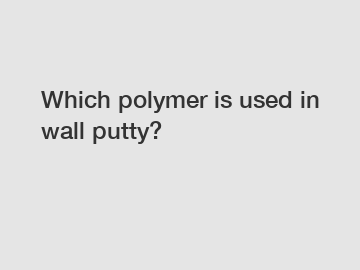Mar. 25, 2024
Chemicals
Goto 圣莱欧 to know more.
If you've ever tried to patch up holes or cracks in your walls, you may have come across wall putty. This versatile material is used to fill in imperfections before painting or wallpapering. But have you ever wondered what exactly wall putty is made of?
What is wall putty?

Wall putty is a type of paste that is used to prepare walls for painting or wallpapering. It is typically applied to cracks, holes, or other imperfections in the wall surface to provide a smooth, even finish. Wall putty is often used to create a smooth base for paint or wallpaper, ensuring a flawless final result.
Which polymer is used in wall putty?
One of the key ingredients in wall putty is a polymer. Polymers are large molecules consisting of repeating structural units, or monomers, that are bonded together. In the case of wall putty, the polymer used is typically acrylic. Acrylic polymers are known for their ability to form a strong, flexible film when they dry, making them ideal for use in wall putty.
Why acrylic polymers?
Acrylic polymers offer a number of benefits that make them well-suited for use in wall putty. For starters, acrylic polymers provide excellent adhesion to a variety of surfaces, ensuring that the wall putty stays in place once it has been applied. Additionally, acrylic polymers have good water resistance, preventing the wall putty from deteriorating over time. Finally, acrylic polymers dry quickly and can be sanded down easily, allowing for a smooth, professional finish.
Featured content:Other ingredients in wall putty.
In addition to acrylic polymers, wall putty also contains a variety of other ingredients that help to improve its performance. These can include fillers such as calcium carbonate or talc, which help to bulk up the putty and provide a smooth texture. Other additives such as cellulose ethers or thickeners may also be included to improve workability and application properties.
How to choose the right wall putty.
When choosing a wall putty for your project, it's important to consider the specific requirements of the job. Different types of wall putty may offer different properties, so be sure to select one that is suitable for your needs. If you're unsure about which wall putty to use, it's always a good idea to consult with a professional or supplier who can provide guidance based on your specific requirements.
In conclusion.
Acrylic polymers are commonly used in wall putty due to their excellent adhesion, water resistance, and ease of sanding. When choosing a wall putty for your project, be sure to consider the specific requirements of the job and consult with a professional or supplier if needed. With the right wall putty, you can ensure a smooth, flawless finish for your walls.
If you have any further questions about wall putty or need assistance choosing the right product for your project, don't hesitate to contact us. Our team of experts is here to help you find the perfect solution for your needs.
Please visit our website for more information on this topic.
For more information, please visit HPMC Manufacturer.
Featured content:Related Articles
If you are interested in sending in a Guest Blogger Submission,welcome to write for us!
All Comments ( 0 )